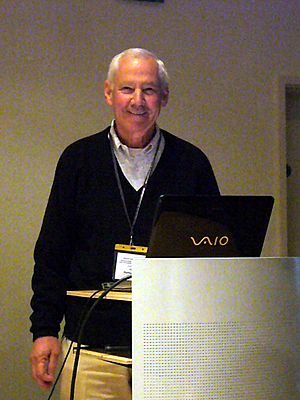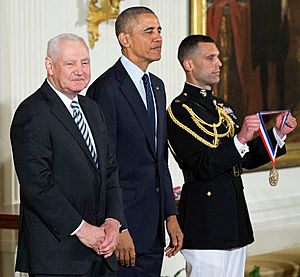Stanley Falkow facts for kids
Quick facts for kids
Stanley Falkow
|
|
|---|---|
 |
|
| Born | January 24, 1934 |
| Died | May 5, 2018 (aged 84) |
| Education | University of Maine Brown University |
| Occupation | Technician, Newport Hospital (1956-1957) Scientist, Walter Reed Army Institute of Research (1961-1966) Professor, Georgetown University (1967-1972) Professor, University of Washington (1972-1981) Professor, Stanford University (1981-2018) |
| Known for | Antibiotic resistance and molecular microbiology research |
| Partner(s) | Rhoda Ostroff (m.1958-1983) Lucy S. Tompkins (m. 1983 - 2018) |
| Children | 2 |
| Awards |
|
| Scientific career | |
| Thesis | An episomic element in a strain of Salmonella typhosa (1960) |
| Doctoral advisor | Charles ("Doc") Arthur Stuart, Brown University |
| Signature | |
 |
|
Stanley "Stan" Falkow (born January 24, 1934 – died May 5, 2018) was an important American scientist. He was a professor of microbiology at several universities, including Georgetown University, University of Washington, and Stanford University School of Medicine.
Falkow is often called the "father of molecular microbial pathogenesis." This means he helped start the study of how tiny living things (microbes) cause diseases at a very detailed, molecular level. He created "molecular Koch's postulates," which are rules that help scientists understand how bacteria cause infections.
For over 50 years, Falkow worked to discover how bacteria make people sick and how we can stop them. He was also one of the first scientists to study how germs become resistant to medicines like antibiotics. He showed how this resistance can spread from one germ to another, a process now called horizontal gene transfer. This work helped us understand how to fight infections in the future.
Contents
Early Life and School Days
Stan Falkow was born in Albany, New York. His family was working-class, and his parents were immigrants. His father sold shoes, and his mother opened a shop.
Even though his family didn't have much money, Stan was very interested in science. When he was 11, he read a book called Microbe Hunters, which made him want to study microbes. He even worked at a toy shop to save money for a microscope! He also admitted to borrowing textbooks, including one about infectious diseases, to learn more.
Stan didn't get great grades in high school until his last year. He later said he was an average student, especially in math. But after he earned his PhD, he worked hard to improve his math skills so he could design and understand his science experiments better. He also gave credit to his teachers, many of whom were talented women who became teachers because other jobs were not open to them at the time. He felt lucky to learn from them.
Education and Career Journey
Stan went to the University of Maine to study biology because it had a good microbiology department. In the summers, he worked at a hospital, helping with lab tests. He graduated in 1955.
Before starting graduate school, Stan had severe anxiety. He was diagnosed with agoraphobia, which made him avoid crowded places. He even dropped out of his first try at graduate school because of panic attacks. He went back home and worked as a technician at a hospital, studying bacteria from patient samples. Later, he went back to graduate school at Brown University and earned his PhD in 1961.
He finished his PhD work at the Walter Reed Army Institute of Research. There, he worked with another scientist named Othello Washington. They worked as a team to study how genes move between different types of bacteria, like E. coli and Salmonella.
Early in his career, some famous scientists told Stan to focus on other things, saying that infectious diseases were not important anymore. But Stan kept studying them, even when he got sick with dysentery from working with infected monkeys! He believed that understanding how germs cause disease was very important.
In the 1960s, Stan's work focused on how bacteria become resistant to antibiotics. He found that bacteria like Shigella have small pieces of DNA called plasmids. These plasmids are separate from the main bacterial DNA and carry special information for survival, like how to resist antibiotics. He showed that bacteria can pass these plasmids to each other, even without mating, which helps spread antibiotic resistance.
In 1966, he became a professor at Georgetown University School of Medicine. Later, he moved to the University of Washington School of Medicine.
In the 1970s, Stan started focusing on the infection process itself. He discovered that a type of E. coli causes a serious diarrhea common in many developing countries. He also helped create a standard way to name bacterial plasmids, which is still used today.
In 1981, he became the head of the Medical Microbiology Department at Stanford University School of Medicine. He encouraged other scientists, like Esther Lederberg, to continue important work, such as running the Stanford Plasmid Reference Center, which keeps track of plasmids for scientists worldwide.
Personal Life and Later Years
Stan Falkow was married to Rhoda Ostroff from 1958 to 1983, and they had two daughters. In 1983, he married Lucy S. Tompkins, who was also a scientist.
Stan and Lucy met when she was a medical student at Georgetown University. At first, Stan didn't want to take female students, which was a common bias in science back then. But Lucy firmly told him he was being unfair. Her argument made Stan change his mind, and he allowed her to work in his lab. After that, Stan became a strong supporter of gender equality in science and helped many women become scientists.
Stan struggled with severe anxiety throughout his career. Early on, he avoided conferences and giving presentations because he would shake and sweat. He learned ways to cope with his anxiety and later used humor in his talks, which made them memorable and enjoyable for his audience. He kept his mental health struggles private from most colleagues, but his chair at Georgetown University helped him get the healthcare he needed.
In 2004, Stan was diagnosed with a serious illness called myelodysplastic syndrome. He passed away on May 5, 2018, at his home in Portola Valley, California, at the age of 84. His death was announced in many science journals and news sources around the world, highlighting his amazing achievements.
Key Discoveries in Microbiology
Stan Falkow is known as the "father of molecular microbial pathogenesis." This field studies how tiny germs and our body's cells interact to cause disease at a very detailed level.
He discovered that germs use special genes that only turn on when they are inside a host (like a human body). His work led to important medical advances, such as a new vaccine for whooping cough.
Falkow and his students developed many important methods that helped science move forward. For example, they found ways to:
- Test patient samples for germs that cause stomach problems.
- Identify Salmonella and Shigella bacteria.
- Use nucleic acid hybridization to tell different bacteria apart.
- Use Agarose gel electrophoresis to separate plasmids of different sizes.
- Create new cloning vectors, which are tools used to copy DNA.
- Identify germs that can't be grown in a lab.
- Improve GFP for studying cells.
- Detect genes that germs turn on inside host cells.
After studying the DNA of many different germs, Falkow was one of the first scientists to suggest that bacteria should be grouped based on their DNA, not just how they look or act.
He also helped create the system for naming plasmids that scientists still use today.
Falkow created "Molecular Koch's postulates," which are rules for figuring out what makes a germ able to cause disease. These rules are still very important in infectious disease research.
Teaching and Helping Others
Stan Falkow loved teaching and believed that all scientists should train the next generation. He taught students at all levels, from medical school to undergraduate classes. He even recorded lectures on microbial pathogenesis that are still available online for anyone to watch. After he retired, he continued to teach a class on the history of infectious diseases with his wife, Lucy Tompkins.
Falkow organized the first international meeting where scientists discussed antibiotic resistance.
He and his student Vickers Herschfield studied water sources in the Washington D.C. area. They found that the Potomac River and Rock Creek, which people thought were clean, actually had a lot of human waste. They told government offices about their findings, but at first, they were ignored. In 1971, Falkow held a press conference to warn people not to let their children play in the Potomac River, saying it was like drinking half a gram of human waste!
Falkow also served on the first committee that recommended rules for using recombinant DNA technology to the United States Congress. Many of his writings were used to create the Recombinant DNA Regulation Act of 1977.
Throughout his career, Falkow worked with the FDA to encourage less use of antibiotics in animal feed, which helps prevent antibiotic resistance.
Awards and Honors
Stan Falkow received many awards for his amazing work in science. He was elected President of the American Society for Microbiology from 1997 to 1998. He also became a member of important groups like the Institute of Medicine, the National Academy of Sciences, and the National Academy of Arts and Sciences. He was even elected as a Foreign Member of the UK's Royal Society.
He received honorary doctorates (special degrees) from universities in Europe and the US. Some of his many awards include:
- The Robert Koch Prize in 2000.
- The Lasker Award for medical research in 2008.
- The National Medal of Science in May 2016, given to him by President Barack Obama. This award recognized his huge contributions to understanding how microbes cause disease and resist antibiotics, and for inspiring many new scientists in the field.
His Students and Trainees
Stanley Falkow was known for training many talented scientists who went on to become important professors and researchers around the world. He helped create a whole new generation of experts in molecular microbiology. Some of his notable trainees include:
- Manuel Amieva
- Igor Brodsky
- Carleen Collins
- Gordon Dougan
- Brett Finlay
- Karen Guillemin
- Carlton Gyles
- Fred Heffron
- Joan Skerman Knapp
- Michael Koomey
- Donald J. LeBlanc
- Ralph Isberg
- Leonard Mayer
- Denise Monack
- Stephen L. Moseley
- Peter Piot
- Daniel Portnoy
- Lalita Ramakrishnan
- David Relman
- Richard P. Silver
- Magdalene Yh So
- Lucy S. Tompkins
- Raphael Valdivia
- Alison Weiss
- Rod Welch
See also
 In Spanish: Stanley Falkow para niños
In Spanish: Stanley Falkow para niños


